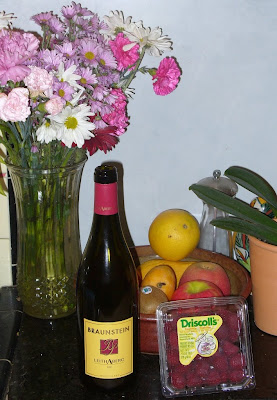The Toronto-based Globe and Mail's wine writer
decided to write a polite missive on the non-virtues of Cab Franc about ten days ago, which I found via several degrees of separation through
Jim's Loire and
Dr. Vino. While the author Beppi Crosariol ultimately offers his readers three selections of Cabernet Franc, he first unleashes a litany of criticism directed towards the varietal. His criticisms:
- [Cab Francs] resemble red sangria that has been steeped with bell peppers and unlit cigarettes instead of fruit.
- It comes on strong with a green, stemmy quality that suggests the grapes just didn't get ripe enough.
- All the people I know who rave about Chinon and Bourgueil are wine geeks, the kind of people who champion varieties nobody else does precisely because nobody else does. You can find many of these same people downloading unsigned artists to their iPods.
Where do I begin with these wrong-minded, ignorant statements? Maybe I should first note that I don't have an iPod. But I am a fan of such unsigned artists as Beethoven, Brahms and Schubert, especially when performed by the unsigned performers of a major symphony orchestra. Clearly my preference for esoterica in the pantheon of Western art music
must transfer over to my taste in wine. No one has heard of Beethoven, after all, much lest Brahms or Schubert.
Getting that disclaimer out of the way, it's important to clarify what Cabernet Franc is and isn't. Jon Bonne of the San Francisco Chronicle and Eric Asimov of the New York Times know what it is. Beppi Crosariol does not. Loire Valley Cabernet Franc is much more closely aligned with Burgundy Pinot Noir than Bordeaux Cabernet despite the Loire and Bordeaux's shared usage of the varietal. The Loire, like Burgundy, is a more marginal climate than Bordeaux. That means one must be acutely aware of vintage as a poor vintage will be especially problematic, and a great vintage absolutely revelatory. Furthermore, cuvées are vinified and bottled based on their vineyard or terroir. Bordeaux has terroir of course, but the chateau and appellation are the major differentiators. Loire Franc must be understood in terms of producer, terroir, appellation and vintage, meaning you cannot generalize at all and need to dabble a good bit to have anything worthwhile to say.
The one partially accurate statement Crosariol makes is that often Loire "grapes just didn't get ripe enough, which is usually the case. It thrives in relatively cool climates, but unless it's left to ripen long into autumn, it can remind you of what the sage critic Robert Parker describes as
yesterday's plate of green beans or asparagus." This is the essence of a marginal climate. The northern-most climate possible is generally the best for Cab Franc. The cool temperatures moderate alcohol levels, while the long summer days provide excellent sun exposure for phenolic development. Because the sugars are moderated by climate, one can achieve long hang-time in the fall for superior flavor development of the fruit provided the weather cooperates. Unfortunately, the weather doesn't always work out. Or growers pick early simply to avoid the complications brought on by rain. However, this does not justify any sort of generalization. This is why, just as with Pinot Noir, knowing the producer and vintage are so important. But even if you gamble blindly on a Chinon or Bourgueil, it shouldn't set you back much more than $15. In the world of wine, that is a rather small tariff for something that may be sublime albeit inconsistent.
Finally, I must comment on bell peppers and tobacco in Cab Franc. I like both, but usually I find tobacco is a riper, refined expression of the varietal. Bell pepper is more primary, less developed. It can get ugly, though, as sometimes Cabernet Franc is simply outright weedy. I don't appreciate this under-ripe expression. But aromas of cigars and capsicum are for me heavenly, and quite consistent with ripe Franc. Just as some people love jam, raisin, vanilla and other candy-like aromas in their wine, I like certain plant-like aromas, especially peppers and tobacco. Similarly, Pinot Noir is often praised for its expression of mushroomy forest-floor aromas, as well as sage or feral elements depending on terroir and producer. How does one objectively value a mushroom over a bell pepper or tobacco leaf? I honestly do not know.
This begs the question, why write an article about something you are both ignorant of and dislike? Crosariol should stick to Napa Cabs, like the
mass-produced Napa Cellars '06 Cab he praised with the following note:
"The aroma is intense and inviting, presaging a ripe, jammy profile on the palate that's just short of raisin-like, with hints of dark chocolate and blackberry. The flavour is impressive, though a technical taster might deduct some points for so-called varietal character; to me it tastes as much like a zinfandel as a cabernet."
Clearly, if your preference is for dessicated, overripe fruit with heavy-handed oak treatment, you have no business discussing Loire Franc. I'm occasionally up for an over-extracted Napa style oak and fruit bomb. But I wouldn't waste much blog space on the topic. It's not a style that I find particularly serious, and making generalization would only be an insult to the minority of Napa producers who opt to make age-worthy wines with savory nuances and classic fruit expression. At least I know raisin, chocolate, vanilla and high alcohol are not varietal characteristics of Cabernet Sauvignon, even if they are expressed in many cocktail wine styled Cabs.
It's not that differing tastes bother me. It's that a certain taste--I'll call it the Parkerized taste--is considered superior. The cult of Parker for some reason feels the need to denigrate that which isn't engineered to its template. Parker himself doesn't do this, and he is respectable in his consistency. But his palate has somehow inspired a cottage industry of mimicry. Thankfully, Loire Cabernet Franc cannot be Parkerized.























